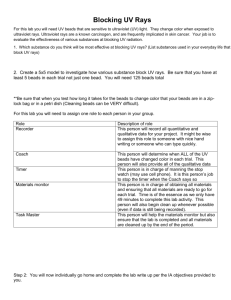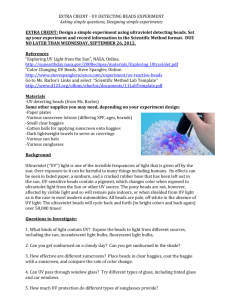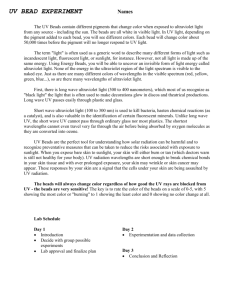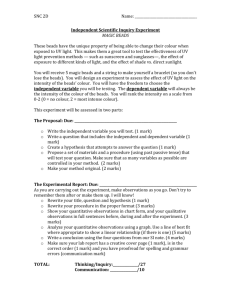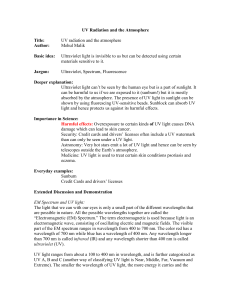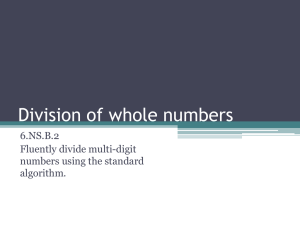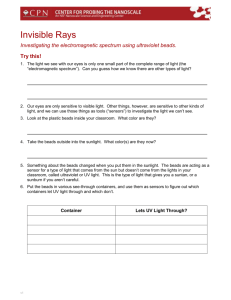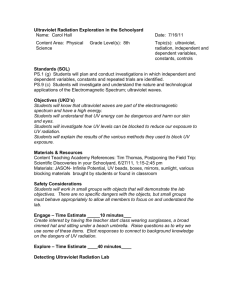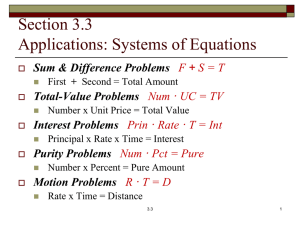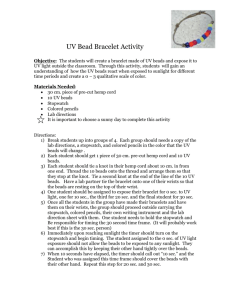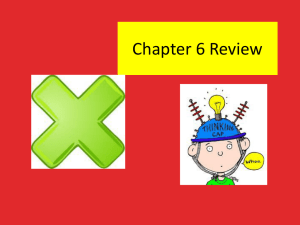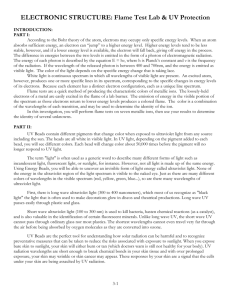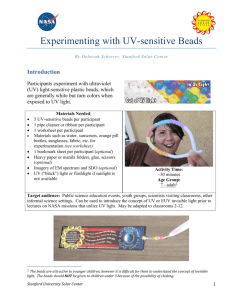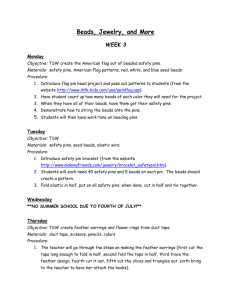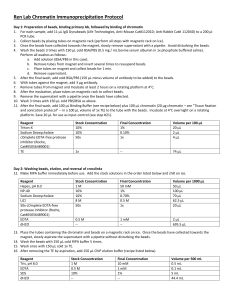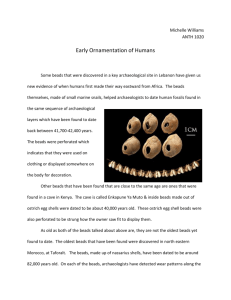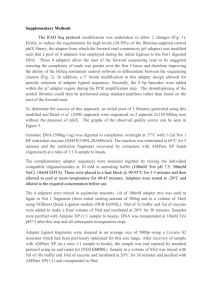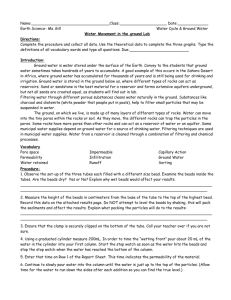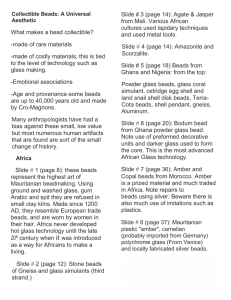Experimenting with UV-sensitive Beads
advertisement
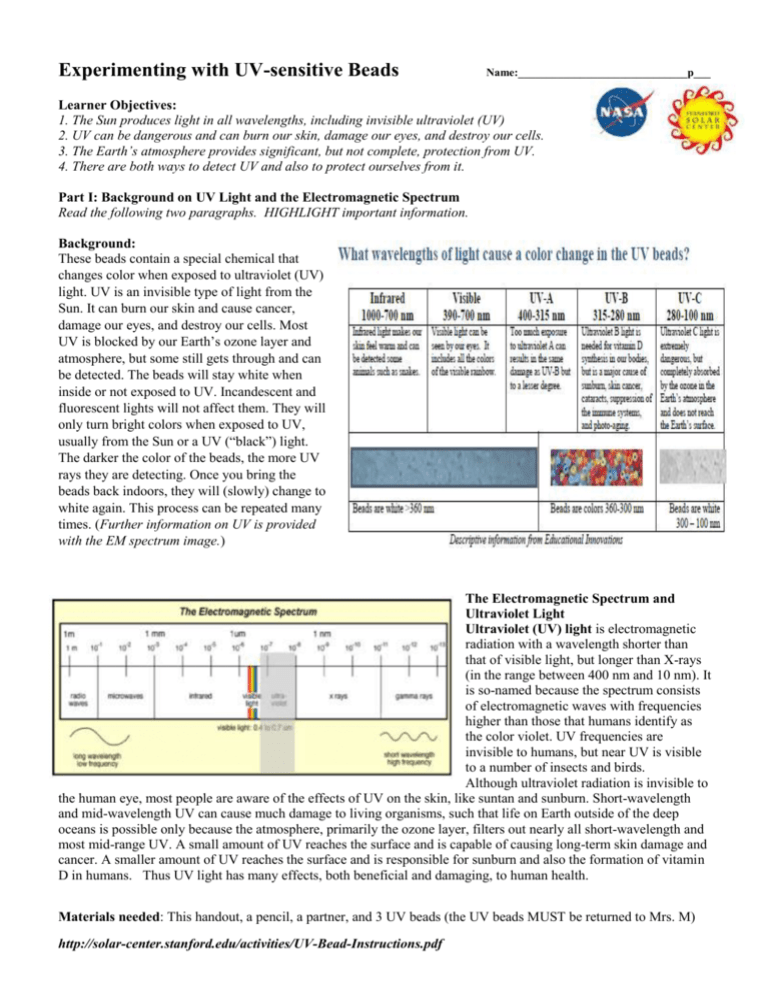
Experimenting with UV-sensitive Beads Name:______________________________p___ Learner Objectives: 1. The Sun produces light in all wavelengths, including invisible ultraviolet (UV) 2. UV can be dangerous and can burn our skin, damage our eyes, and destroy our cells. 3. The Earth’s atmosphere provides significant, but not complete, protection from UV. 4. There are both ways to detect UV and also to protect ourselves from it. Part I: Background on UV Light and the Electromagnetic Spectrum Read the following two paragraphs. HIGHLIGHT important information. Background: These beads contain a special chemical that changes color when exposed to ultraviolet (UV) light. UV is an invisible type of light from the Sun. It can burn our skin and cause cancer, damage our eyes, and destroy our cells. Most UV is blocked by our Earth’s ozone layer and atmosphere, but some still gets through and can be detected. The beads will stay white when inside or not exposed to UV. Incandescent and fluorescent lights will not affect them. They will only turn bright colors when exposed to UV, usually from the Sun or a UV (“black”) light. The darker the color of the beads, the more UV rays they are detecting. Once you bring the beads back indoors, they will (slowly) change to white again. This process can be repeated many times. (Further information on UV is provided with the EM spectrum image.) The Electromagnetic Spectrum and Ultraviolet Light Ultraviolet (UV) light is electromagnetic radiation with a wavelength shorter than that of visible light, but longer than X-rays (in the range between 400 nm and 10 nm). It is so-named because the spectrum consists of electromagnetic waves with frequencies higher than those that humans identify as the color violet. UV frequencies are invisible to humans, but near UV is visible to a number of insects and birds. Although ultraviolet radiation is invisible to the human eye, most people are aware of the effects of UV on the skin, like suntan and sunburn. Short-wavelength and mid-wavelength UV can cause much damage to living organisms, such that life on Earth outside of the deep oceans is possible only because the atmosphere, primarily the ozone layer, filters out nearly all short-wavelength and most mid-range UV. A small amount of UV reaches the surface and is capable of causing long-term skin damage and cancer. A smaller amount of UV reaches the surface and is responsible for sunburn and also the formation of vitamin D in humans. Thus UV light has many effects, both beneficial and damaging, to human health. Materials needed: This handout, a pencil, a partner, and 3 UV beads (the UV beads MUST be returned to Mrs. M) http://solar-center.stanford.edu/activities/UV-Bead-Instructions.pdf Part II: You Be the Scientist!!!! Determine which materials keep the beads (and you!) safe from dangerous UV radiation and which ones don’t. Test your beads with the various items on the worksheet. Do they look white, faint, or colored? Think of 5 additional items to test, to add to your list. If you were unable to test the beads due to lack of materials or wrong time of day, please write N/A under the section “Actual color of beads”. Your Prediction (Do you think the beads will be white, faint, or colored?) In direct sunlight Cloudy sky (overcast, no direct sunlight) In shadow Underneath notebook paper Underneath sunglasses Under cloth Inside a clear plastic container Inside a colored plastic container In the classroom Behind glass Underneath a leaf Under the brim of a hat Sun at mid-day Sun at sunrise/set Night time UV black light Under fluorescent lightbulb Under incandescent lightbulb Under LED light With Sunblock Under water 1. 2. 3. 4. 5. Actual color of the beads Safe from UV? N/A N/A *1-5 Your choice. What is UV light? What are some effects of being exposed to UV light? Which of the materials listed are MOST effective at keeping you safe from dangerous UV light from the sun? What time of day do you think you are most at risk? Least risk? What season of the year?
